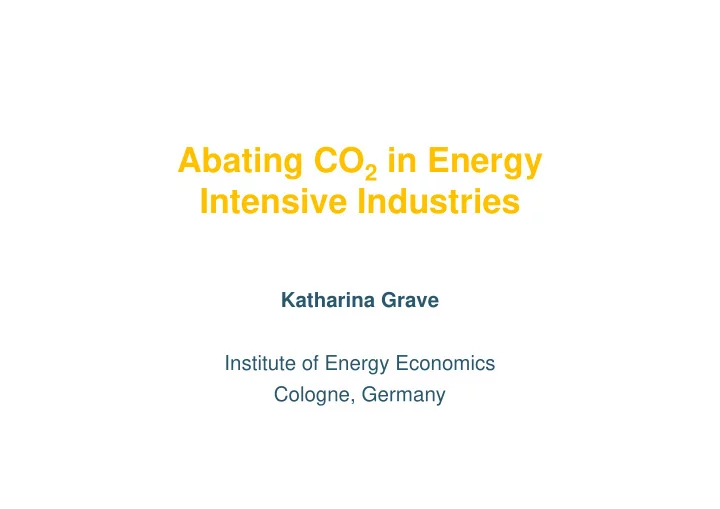

Abating CO 2 in Energy Intensive Industries Katharina Grave Institute of Energy Economics Cologne, Germany
Agenda 1. Aim 2. Theoretical Approach 3. Quantifying Abatement Potentials 3. Quantifying Abatement Potentials 4. Implementation 5. First Results 0 � ��� �������������������������������������������������������� ��������������� ������������� ���!"� ����#�����������$��������"��������!�� � %������"&���'���(��&��)*)
Aim Analyse the structure of the “other half“ of the emissions covered by the European Emission Trading System and quantify CO -abatement potentials quantify CO 2 -abatement potentials outside the energy sector 1 � ��� �������������������������������������������������������� ��������������� ������������� ���!"� ����#�����������$��������"��������!�� + %������"&���'���(��&��)*)
Theoretical Approach: Analysing CITL Combustion [1] The main category: Refineries [2] Combustion Iron & Steel [3;4;5] Cement [6] Glass [7] Ceramics [8] Pulp & Paper [9] Pulp & Paper [9] Other [99] Verified Emissions 2009 2 � ��� �������������������������������������������������������� ��������������� ������������� ���!"� ����#�����������$��������"��������!�� , %������"&���'���(��&��)*)
Theoretical Approach: Analysing CITL Combustion [1] main industrial emitters: Refineries [2] iron and steel, Iron & Steel [3;4;5] cement, Cement [6] Glass [7] and refining Ceramics [8] Pulp & Paper [9] Pulp & Paper [9] Other [99] Verified Emissions 2009 2 � ��� �������������������������������������������������������� ��������������� ������������� ���!"� ����#�����������$��������"��������!�� - %������"&���'���(��&��)*)
Theoretical Approach: Analysing CITL Combustion [1] main industrial emitters: Refineries [2] iron and steel, Iron & Steel [3;4;5] cement, Cement [6] Glass [7] and refining Ceramics [8] Pulp & Paper [9] Pulp & Paper [9] Other [99] Problem: Combustion is also a main process in the Verified Emissions 2009 industrial sector 2 � ��� �������������������������������������������������������� ��������������� ������������� ���!"� ����#�����������$��������"��������!�� . %������"&���'���(��&��)*)
Theoretical Approach: Analysing CITL Combustion [1] Refineries [2] Iron & Steel [3;4;5] Cement [6] Glass [7] Ceramics [8] Pulp & Paper [9] Pulp & Paper [9] Other [99] What part of it Verified Emissions 2009 belongs to the industrial sector? 2 � ��� �������������������������������������������������������� ��������������� ������������� ���!"� ����#�����������$��������"��������!�� / %������"&���'���(��&��)*)
Theoretical Approach: Analysing CITL Trotignon/Delsbosc: Combustion Cogeneration/Heat 15% is emitted in Industrial Combustion Refineries [2] cogeneration plants Iron & Steel [3;4;5] Cement [6] Cement [6] 10% are industrial Glass [7] Ceramics [8] emissions Pulp & Paper [9] Other [99] 2 � ��� �������������������������������������������������������� ��������������� ������������� ���!"� ����#�����������$��������"��������!�� 0 %������"&���'���(��&��)*)
Quantifying Abatement Potentials: Collecting Data • Industrial studies (specific and general) • Institutes • Institutes • Stakeholder-Interviews 3 � ��� �������������������������������������������������������� ��������������� ������������� ���!"� ����#�����������$��������"��������!�� � %������"&���'���(��&��)*)
Quantifying Abatement Potentials: Classification 1) Specific abatement - Electric arc furnaces instead of integrated steel mills - Clinker substitution 2) Fuel-switching 3) Carbon capture and storage (CCS) 4) Carbon leakage 3 � ��� �������������������������������������������������������� ��������������� ������������� ���!"� ����#�����������$��������"��������!�� *) %������"&���'���(��&��)*)
Quantifying Abatement Potentials: Variables • Production (covered by ETS) • Average emissions per tonne - Process emissions - emissions from combustion - emissions from combustion • Electricity demand • Costs of abatement per tonne • Exogenous limits of applicability 3 � ��� �������������������������������������������������������� ��������������� ������������� ���!"� ����#�����������$��������"��������!�� ** %������"&���'���(��&��)*)
Quantifying Abatement Potentials: Variables • Production (covered by ETS) • Average emissions per tonne For each - Process emissions state - Emissions from combustion - Emissions from combustion + + • Electricity demand For each industry • Costs of abatement per tonne • Exogenous limits of applicability 3 � ��� �������������������������������������������������������� ��������������� ������������� ���!"� ����#�����������$��������"��������!�� *� %������"&���'���(��&��)*)
Example: Cement Clinker Production Costs 45 40 35 Depreciation 30 st (€/t) Maintenance 25 Cost 20 G&A Electricity: 60 kWh/t 15 Elektricity 10 Heat: 3.4 – 4 GJ/t Combustibles 5 0 Labour AT BG CZ DK- FI DE HU IT LT MLT PL RO SI SE NO Raw material W State 3 � ��� �������������������������������������������������������� ��������������� ������������� ���!"� ����#�����������$��������"��������!�� *+ %������"&���'���(��&��)*)
Example: Cement Process-Emissions: Process-Emissions: 0.525 tCO2/t clinker 0.525 tCO2/t clinker Combustion Emissions: 0.33 tCO2/t clinker 3 � ��� �������������������������������������������������������� ��������������� ������������� ���!"� ����#�����������$��������"��������!�� *, %������"&���'���(��&��)*)
Recommend
More recommend